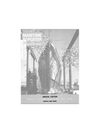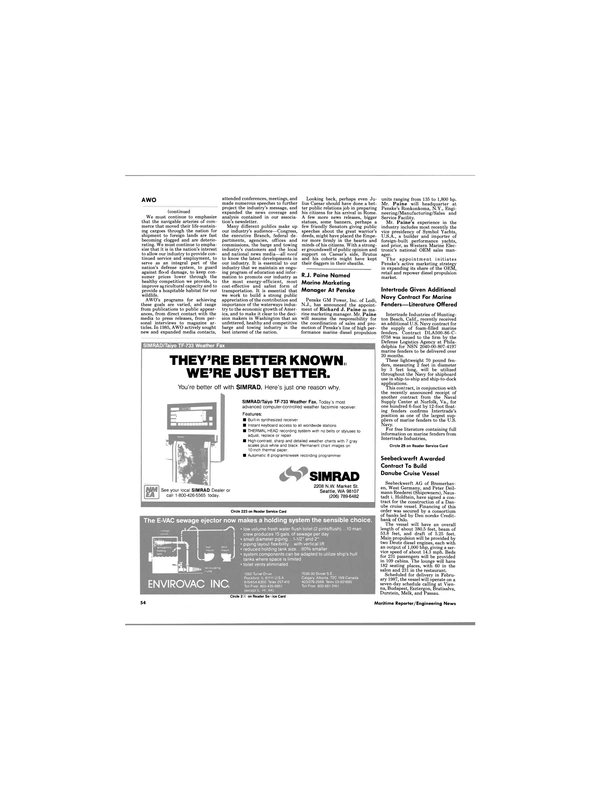
THE INVISIBLE INDUSTRY
The practice of communicating information in order to influence actions, create a desired public image, or shape viewpoints, can be traced from the earliest civilizations.
Much of what is known today of ancient Egypt, Assyria, and Persia comes from material intended to promote and glorify the rulers of that day. Much of ancient literature and art was designed to build support for kings, priests and other leaders. The walls of Pompeii were inscribed with election appeals.
Caesar artfully prepared the Romans for his crossing of the Rubicon in 49 B.C. by issuing "news releases" to Rome on his epic achievements as governor of Gaul.
The techniques for courting public opinion and appreciation have become much more sophisticated today, but the value of such activity is nonetheless constant and, indeed, increasing. What is also constant is that in the space age—high-technology public relations and public affairs arena of today's politics, the barge and towing industry does not, and cannot, compete. The results of this nonparticipation are, in my opinion, catastrophic for our industry.
To say that the inland and coastal barge and towing industry suffers from an image problem is a vast understatement. Compared to our competitors, we are relatively invisible to the nation's public. Millions of Americans each year travel for business or pleasure by jet aircraft.
Every day, the public encounters countless trucks on the highways.
The railroads crisscross the nation in a huge, highly visible and audible network of tracks and trains. But the silent, lumbering, cargo-laden barges, towboats and tugboats that ply the inland and coastal waters of the nation—carrying a full 13 percent of the nation's freight—are relatively unnoticed, and unknown, by the very people who benefit from the products we deliver and from the efficiency and low prices we provide.
This obscurity from the public eye is damaging to us as an industry.
If indeed our contribution to the nation's economy is invisible to the public, then it is likely to be invisible to those who represent the public— the United States Congress.
The millions and millions of dollars spent by the industries with which we compete each year on public relations campaigns, grassroots lobbying efforts, political action committees and advocacy advertising are not wasted on their intended audiences—and when the time comes for the lawmakers to make decisions about these industries, the perception generated by the natural, as well as the highly-promoted visibility of these industries, can only act in their favor—and probably against our less visible industry.
As veteran newscaster Daniel Schorr put it recently, "If you don't exist in the media, you don't exist at all." And this is largely the case with our industry.
Much of the tug and barge industry's obscurity from public notice or concern, is our industry's own fault.
Our industry has not, in the past, done enough, on enough of the right things, to tell our story to the American public, and, by extension, to the men and women who represent them in Washington and in the state capitals.
Our self-imposed invisibility is compounded by a bad habit exercised by many in the media and the government of characterizing the domestic waterways industry as the "pork barrel" industry. These facile types like to glibly caricature a greedy parochial politician with his face stuck in the public trough, lapping up "pork barrel" water project goodies for the voters back home.
Any given lock and dam project, or any given port improvement project, is fair game to be labelled as a monumental and unnecessary "pork barrel" boondoggle, promoted by legislators and an industry that are concerned only with getting their particular slice of the federal budget pie.
Such indulgent cartoon characterizations are frustrating and damaging to us in the waterways industry, as well as to many in our government who understand the industry and support it. And our frustration is exacerbated because the facts, the cold hard statistical data on the importance of the waterways industry to the nation, are in direct refutation to the "pork barrel" image. And hardly anyone knows it.
AWO continues to concentrate much of its public affairs effort at confronting this major and damaging image problem. We have published numerous articles on the subject, given speeches in an attempt to debunk it, and have woven it as a theme in most of our contacts with government officials, other organizations, journalists and many others.
The "pork barrel" case will continue to be tried in the court of public opinion. Changing the mindset of the American people about so ingrained and reinforced a prejudice is nothing short of a monumental task, so we will need to persevere and expand our efforts throughout 1986 and beyond.
In addition to working at dissolving the myth of the "pork barrel," it is essential that this industry continue to demonstrate that all Americans have a real stake in the wellbeing of the American waterway system. Unfortunately, it is little known that the benefits provided through commercial navigation are immense. So, to, the waterways serve the national defense, agricultural, wildlife, economic development and recreation interests of the nation.
We must continue to emphasize that the navigable arteries of commerce that moved their life-sustaining cargoes through the nation for shipment to foreign lands are fast becoming clogged and are deteriorating.
We must continue to emphasize that it is in the nation's interest to allow our industry to provide continued service and employment, to serve as an integral part of the nation's defense system, to guard against flood damage, to keep consumer prices lower through the healthy competition we provide, to improve ag ricultural capacity and to provide a hospitable habitat for our wildlife.
AWO's programs for achieving these goals are varied, and range from publications to public appearances, from direct contact with the media to press releases, from personal interviews to magazine articles.
In 1985, AWO actively sought new and expanded media contacts, attended conferences, meetings, and made numerous speeches to further project the industry's message, and expanded the news coverage and analysis contained in our association's newsletter.
Many different publics make up our industry's audience—Congress, the executive Branch, federal departments, agencies, offices and commissions, the barge and towing industry's customers and the local and national news media—all need to know the latest developments in our industry. It is essential to our industry that we maintain an ongoing program of education and information to promote our industry as the most energy-efficient, most cost-effective and safest form of transportation. It is essential that we work to build a strong public appreciation of the contribution and importance of the waterways industry to the economic growth of America, and to make it clear to the decision makers in Washington that an unfettered, healthy and competitive barge and towing industry is the best interest of the nation.
Looking back, perhaps even Julius Caesar should have done a better public relations job in preparing his citizens for his arrival in Rome.
A few more news releases, bigger statues, some banners, perhaps a few friendly Senators giving public speeches about the great warrior's deeds, might have placed the Emperor more firmly in the hearts and minds of his citizens. With a stronger groundswell of public opinion and support on Caesar's side, Brutus and his cohorts might have kept their daggers in their sheaths.
Read THE INVISIBLE INDUSTRY in Pdf, Flash or Html5 edition of March 1986 Maritime Reporter
Other stories from March 1986 issue
Content
- BUILD AND CHARTER' —A VITAL STEP IN THE RIGHT DIRECTION page: 6
- Navy Adding 13 Ships Costing $206.7 Million To Ready Reserve Force —Four To Be Converted page: 7
- Lips Designs Detachable Blade Propellers For Amoco page: 7
- Gary Carlson Joins Midland-Ross Corp. As Group Executive VP page: 8
- WATERCOM Telecommunications System To Be Fully Operational This Year page: 8
- $31-Million Development Project Begins At Port Of Miami page: 9
- B&B Dredging Offers Color Brochure On New Dredge Design page: 10
- Moss Point Marine Converts Tanker Into Oceangoing Grain Barge page: 10
- Grow Group Announces Merger Of Devoe Prufcoat And Napko Corporation page: 10
- Todd's San Pedro Yard Launches Guided Missile Frigate 'Davis' page: 11
- LATEST CHANGES IN U.S. NAVY SHIPBUILDING PROGRAM page: 12
- NEW NAVY BUDGET: OVER $100 BILLION page: 22
- NAVY CONTRACTS page: 30
- USCG Awards Aquafacs Inspection, Maintenance And Repair Contract page: 33
- Teleflex RMVAs Eliminate Corrosion, Misalignment And Binding Problems page: 33
- Marine Corps League's 6th Annual Exhibition Set For July 22-24 In D.C. page: 36
- 1986 VALVE EQUIPMENT GUIDE page: 38
- Fincantieri Awarded Orders For Seven Ships page: 45
- Japan Radio Offers New Literature On Products— GSC-80 ODARS And JLR-4000 GPS Navigator page: 45
- Bonner Elected Chairman, Solley Vice Chairman Of VMA page: 46
- Infrasonik Receives Order For Soot-Removal Systems From U.S. Shipping Line page: 47
- AWO: PROMOTING, PROTECTING AND DEFENDING THE BARGE AND TOWING INDUSTRY page: 48
- INTERCEPTING AND INFLUENCING THE REGULATORY PROCESS page: 49
- THE BARGE AND TOWING INDUSTRY: A LEGISLATIVE REVIEW page: 50
- THE INVISIBLE INDUSTRY page: 52
- R.J. Paine Named Marine Marketing Manager At Penske page: 54
- Intertrade Given Additional Navy Contract For Marine Fenders page: 54
- Stellar Technology's Battleship Spare Parts Depot Locates In Camden page: 55
- Coastal Corporation Purchase Of Texaco Terminal And Pipeline Interest Expands Market For Belcher Oil page: 56
- Big Heavy-Lift Cargo Carrier Delivered By Hitachi Zosen page: 56
- Free 28-Page Color Catalog On Bearings Offered By Duramax page: 58
- Kockums To Retrofit Swedish Sub With Air-Independent Stirling Engine page: 59
- Curtis Bay Towing Elects Swensen VP And General Manager page: 59
- Hempel Group Founder Dies At Age Of 91 page: 60
- Duff And Butera Hired At CDI Marine Company page: 60
- Record Well Depth For Floating Drilling Rig Set By ODECO's 'Ocean Rover' page: 61
- Michell Bearings Appoints Peter Pagan President page: 61
- TDI Introduces New Infrared Thermometer Kit page: 61
- MarineSafety Initiates Tug-Barge Simulator Training Course page: 62
- Alden Introduces Series Of Marinefax Recorders page: 62
- New Aeroquip Bulletin Explains Hose Assembly Machine Advantages page: 64
- Wtirtsilti Delivers Advanced Icebreaker To Finnish Board Of Navigation page: 64
- Congressional Conferees Agree To Appropriate $228.4 Million For Strategic Sealift Program page: 65
- SNAME Chesapeake Section Meeting Hears Paper On SWATH Survey Ship page: 65
- Garrett Division To Participate In Design Of New Engine For Mid-Sized Navy Ships page: 68
- Lindenau Installs Firefighting System On Offshore Supply Boat page: 69
- Schaffran Offers Free Literature On Propellers And Shaft Liners page: 69
- Marco-Seattle Awarded Cargo Ship Conversion page: 70
- Ellicott Machine Forms New Engineering Company —Morse Named Manager page: 70
- Wartsila Delivers Passenger/Vehicle Ferry To EFFOA-Finland Steamship page: 75


